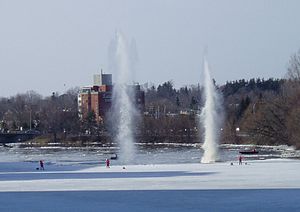| Revision as of 02:35, 18 August 2006 edit203.208.80.250 (talk)No edit summary← Previous edit | Revision as of 02:38, 18 August 2006 edit undoAz1568 (talk | contribs)Extended confirmed users, Pending changes reviewers, Rollbackers7,727 editsm JS: Reverted edits by 203.208.80.250 to last version by 62.150.153.230.Next edit → | ||
| Line 1: | Line 1: | ||
| ] in ]]] | |||
| '''Ice blasting''' is the use of ] to break up ] in rivers, greatly aiding navigation systems. | |||
| '''Ic'''Bold text'''<math>Insert formula here</math>#REDIRECT ]#REDIRECT ]#REDIRECT ] | |||
| ⚫ | This is done during the spring when snow is melting and river ice is breaking up. There is always a chance that the ice flows could collide creating an ] creating a ] and blocking the river. The river, filled with melt water, will quickly ] and often cause damage nearby settlements. Thus in most northern areas governments quickly act to break up the ice jams before they can do much damage. This is most easily done with explosives. These explosives may be planted from the shore, or in some cases by helicopter. In the large rivers of the ] the Russian airforce is sometimes called in to bomb ice jams. | ||
| ---- | |||
| ⚫ | |||
| Some districts, where flooding is especially common, do preemptive |
Some districts, where flooding is especially common, do preemptive ice blasting. The city of ], ], for instance, blasts the ] each spring to break up the ice. | ||
| This is done during the spring when snow is melting and river ice is breaking up. There is always a chance that the ice flows could ice blasting. The city of ], ], for instance, blasts the ] each spring to break up the ice. | |||
| Ice blasting has a number of disadvantages. It is expensive and dangerous requiring highly skilled explosives experts. When blasting is occurring the public must be warned to keep their distance. The blasting has negative environmental consequences. Fish and other river creatures are inevitably killed and the river bottom is scarred. Those who live near the rivers complain about the loud noise and some allege that the blasting causes structural damage to homes. | Ice blasting has a number of disadvantages. It is expensive and dangerous requiring highly skilled explosives experts. When blasting is occurring the public must be warned to keep their distance. The blasting has negative environmental consequences. Fish and other river creatures are inevitably killed and the river bottom is scarred. Those who live near the rivers complain about the loud noise and some allege that the blasting causes structural damage to homes. | ||
Revision as of 02:38, 18 August 2006

Ice blasting is the use of explosives to break up ice in rivers, greatly aiding navigation systems. This is done during the spring when snow is melting and river ice is breaking up. There is always a chance that the ice flows could collide creating an ice jam creating a dam and blocking the river. The river, filled with melt water, will quickly flood and often cause damage nearby settlements. Thus in most northern areas governments quickly act to break up the ice jams before they can do much damage. This is most easily done with explosives. These explosives may be planted from the shore, or in some cases by helicopter. In the large rivers of the Siberia the Russian airforce is sometimes called in to bomb ice jams.
Some districts, where flooding is especially common, do preemptive ice blasting. The city of Ottawa, Canada, for instance, blasts the Rideau River each spring to break up the ice.
Ice blasting has a number of disadvantages. It is expensive and dangerous requiring highly skilled explosives experts. When blasting is occurring the public must be warned to keep their distance. The blasting has negative environmental consequences. Fish and other river creatures are inevitably killed and the river bottom is scarred. Those who live near the rivers complain about the loud noise and some allege that the blasting causes structural damage to homes.
Category: